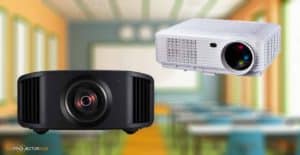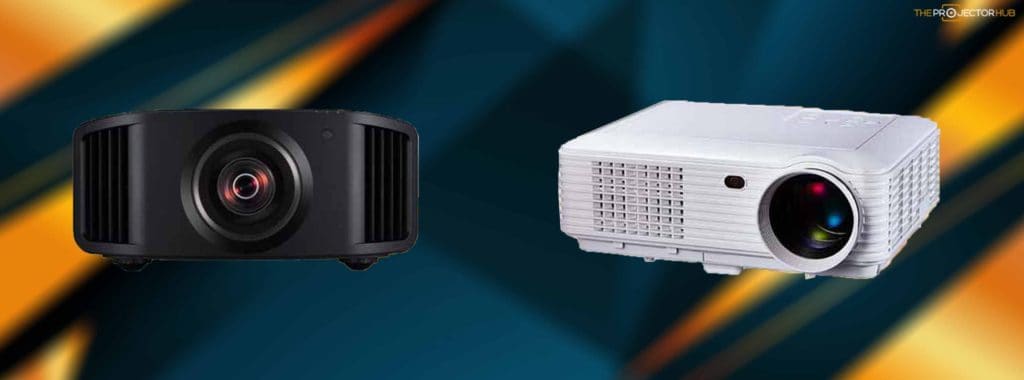
Are you looking for the best Projector for classroom teaching? Whether you’re a teacher new to projector technology or just looking to upgrade, we’ve got you covered. We’ll walk you through everything you need to know before making your purchase and share our top picks for classroom projectors.
There are a lot of different factors to consider, but we’ll help make your decision easier.
Resolution
The resolution is one of the most important factors to consider when choosing a projector for the classroom. You’ll want to ensure that your chosen Projector has a high enough resolution to clearly display your lesson plans and presentations.
Read more about: What Is A Good Resolution For A Classroom Projector.
- Color Resolution
Color Resolution talks about the number of colors each pixel generates (or is capable of generating). The image will be more life-like the more colors the pixels it’s made up of can generate.
In the early 90’s the goal for each pixel was 16 million colors. Now, new projectors boast more than 68 million colors per pixel.
- Image Resolution
Each image is made up of tiny dots, each making up the whole picture. If a photo is taken and is run through a shredder, all the specs of photo paper could be pieced together (in theory) to make the original image. This is what projectors do. They take images that are broken down in to pixels and pieces them together into projections that are displayed on screens, making an image.
The more pixels there are the higher the resolution of the projector and the better the image is regardless of if it is a video or test. The projector’s resolution decides the detail a projector can deliver.
There are a couple of ways to describe resolution:
- In acronym form : XGA, SVGA, HD, WXGA
- Vertical and Horizontal pixels the projector is capable of displaying in width and height.
- XGA is 1024 x 768
- HD 720 is 1280 x 720
- HD is 1920 x 1080
- SVGA is 800 x 600
The more pixels your projector is capable of displaying, the better the image detail will be when the image is enlarged. If you’re using a 4:3 aspect ratio, the two choices you’ll primarily be able to use would be XGA or SVGA, with XGA being able to deliver the better image.
Brightness
Another important factor to consider is brightness. You’ll want to ensure that your chosen Projector is bright enough to be seen clearly in a classroom setting. If you are unsure about projector lumens, read our detailed guidelines. You’ll want to consider a few things, such as:
- How much ambient light is in the room?
Dark rooms give the best image despite the brightness of the projector. Keeping a room dark isn’t considered ideal in places where note-taking, interaction, and eye contact are a part of the goal. Classrooms where lights can’t be turned off or where they can’t be dimmed from inside the room or even where the windows can’t be covered or blocked will require a projector with a high brightness rating. These same projectors when placed in dark rooms may result in eye strain; most projectors, however have an economy mode that allows individuals to lower the brightness the projector puts out by 20 percent while extending the life of the lamp at the same time.
- What is the screen’s gain?
Screens reflect a fixed amount of light; the place the screen distributes the light is decided by the screen’s gain. Screens with a gain of 1 provide the highest angle. This means, essentially, students to the right and left of the screen will be able to see the image easily. Screen with a higher gain that 1 increase the brightness of the content towards the room’s center at the expense of displaying dimmer content to the room’s sides. This also means that higher screen gain have narrower viewing angles. Gains between 1 – 1.5 are suitable for classrooms. If you’ll need a higher gain check with the screen supplier or your your installer.
- How far away is the furthest student?
The answer to this question will help you determine the size of the image required by students. The bigger an image is, the brighter the projector will have to be for the image to be seen. The screen’s height should be around 1/6 of the distance to the furthest student.
- What kind of screen will be used?
Most of today’s screens make allowances for light that strikes the screen at extreme angles so they’re absorbed rather than reflected by the screen. This also helps them maintain high image quality by completely removing light and maintaining both image quality and contrast.
- Can a chalkboard or wall be used for a screen?
Yes, chalkboards and walls can be used as screens but beware that both brightness and image quality will suffer. Most of projectors today, have a blackboard mode. This mode essentially determines the projection surface’s quality and optimizes the projected color accordingly. If you want to have this option, make sure to seek a demonstration so you are sure that you’re satisfied with the delivered results.
Inputs
You’ll also want to ensure that the Projector you choose has the proper inputs for your needs. If you plan on using a laptop or other computer with your Projector, you’ll need to ensure that it has the correct input ports.
Ceiling mount
If you’re looking for a projector for the classroom, you may want to consider one that can be ceiling mounted. This will allow you to free up desk or table space in the classroom.
Screen size
Finally, you’ll want to consider the screen size. You’ll want to ensure that the Projector you choose can project onto a large screen for your classroom.
If the projector you purchase doesn’t come with a screen, you may want to consider purchasing one when you choose a projector as the image will be better on a screen rather than being projected onto a chalkboard or a wall. Having a better image quality helps keep your student’s attention.
To figure out which screen size you need, measure the distance from where you’d like to put the screen to the student that is the furthest away from the screen. The screen’s height should be 1/6 of the distance. This height is suitable for both text and video. The student closest to the screen, shouldn’t be any closer to the screen that double the screen’s height and the screen’s bottom should be at least 4 ft above the floor to be seen the whole class.
Contrast Ratio
In its simplest form, contrast ratio is the ratio of light that’s reflected from an all black image and an all white image. Projectors with 3000:1 contrast ratios mean that the white image is 3000 x brighter than the black image. The higher the contrast ratio, the more detail one will be able to see on the projected image + regardless of it’s video, text, pictures, graphs, or numbers. Contrast allows us to see the subtle shading colors. It essentially about detail.
Four things in the classroom will have an effect on contrast:
- Your screen: Make sure to use a projector screen instead of a chalkboard or wall
- The color of the classroom’s ceiling, floor, and walls: The darker the classroom, the better
- Lights in the room: Turn down all lights if you can
- Uncovered windows: Cover all windows if you can
If you’ve done all things listed above, your last option is to opt for a brighter projector. Bright projectors can mitigate, not get rid of, the impact of ambient light on projected images.
Keystone Correction
If a projected image didn’t look rectangular to you before, then you’ve experienced keystone errors before. This issue comes up when the projector isn’t perpendicular with the surface projected on.
If the bottom and top of the image are at different lengths, then the vertical lens shift may fix this issue. All you have to do is, without moving the projector, using the vertical lens shift, lower or raise the image to turn the trapezoidal image into a rectangular one.
If you’re aware of keystone issues, you may be wondering, “Why not use digital keystone features?”. Digital keystone features are usually present on most projectors nowadays and allows projectors to square the image if it is slightly off. Just make sure you know that using digital keystone correction can cause a few issues that might get in the way of your use.
For starters, it’ll square the content by using digital scaling to shrink the long side of the image. All this means is that information is removed which results in the scaling artifacts being evident in the content.
ex. Text will be kind of blurry in the area of the image that’s scaled. The blurriness won’t be as evident if you’re projecting photos or video. It can also result in some loss of brightness due to the image being smaller the display’s native resolution. If you’re moving a projector between classrooms or if there are constraints in a fixed installation, the horizontal or vertical lens shift will be the best solution.
Networking
If you’ve ever had to connect to the internet or a computer network then you understand how powerful networking is. Networks allow us to manage devices and share information between large groups of people remotely. Projectors can also be networked.
By networking a projector one can save money and time. Projectors must have either a wireless or wired connection that identifies it uniquely among all the projectors in the school. With this distinct address, school IT administrators are able to locate the projector within the network, detect a possible lamp failure or theft, communicate with it, connect it to the internet, identify the need for troubleshooting or maintenance, connect a group of projectors for a common presentation, permit the sharing of course material, or make sure all projectors that aren’t being used are shut down to lower lamp replacement costs.
Portable Projectors
Typically, the projector’s weight is in direct relation to what it’s used for as well as its brightness. Out of the nearly 1200 projectors on the market they have a weight range of 400 pounds for the more heavy duty projectors (higher brightness) and 5 ounces for the lightest pico projector.
if one looks at the entire group of portable projectors (less than or equal to 5 pounds), we’ll find that the average lumens per pound is at 35.2. When weight is an issues, regardless of where you’re traveling to, you’ll still want to have a projector that delivers adequate brightness. Portable projectors will deliver this, but one must also consider fan noise.
The more brightness delivered by the projector, the more heat it will generate and in smaller projectors, getting rid of this heat can be difficult. Make sure to check out the audible noise rating on the projector before you purchase it.
The audible noise rating is measures in dB (decibels). Projectors with an audible noise rating of 30 are about as quiet as a library while those with a noise rating of 65dB is around that of normal conversation. When you choose a projector make sure to consider the audible noise. Too much audible noise will serve as a distraction to your and your company. Before regular use try to test the projector out to see how loud the cooling system really is.
*side note: lower frequency sounds are usually more distracting than lower frequency ones
More portable projectors do, however, have a higher likelihood of being stolen, especially if it is shared and moved frequently between areas. Try out a policy that ensures that it is returned to it’s original area after use to prevent theft.
Interactive Whiteboards
If you’d like something that is 4 presentation tools in one, consider purchasing an interactive whiteboard. They can be used as following:
- A projector screen
- Interact whiteboard
- Traditional whiteboard
- An electronic copy board
The true potential of an interactive whiteboard is typically seen when used as an interactive whiteboard(sounds redundant, we know). Projectors project a computer’s desktop onto the interactive whiteboard, which allows the instructor to control the app with the use of a finger, pen, or something similar rather than clicking a mouse or a keyboard. The information shown on the whiteboard will be captured and saved so it can be used later.
Boards are typically on a floor stand or mounted onto a wall. Screens can then be used to show computer software, videos and web pages to a class, regardless of what the content is on originally (CD-ROM, DVD, or VHS).
Throw Distance & Zoom
The throw distance is the distance from the projector Len’s tip to the screen.
The throw distance decides where the projector sits in the class in relation to the projector’s screen. For a projector, the image’s width(W) in relation to the throw distance(D) is called the throw ratio (D/W). The most common throw ratio is 2.0. For each foot of image width, the projector has to be 2 feet away or D/W is 2/1 which equals 2.0. If you’re using a projector with a 2.0 throw ratio have an image width of 5 feet, then the throw distance is 10 feet. If the distance from the screen is 20 feet the image is 10 feet wide. The throw ratio is a simple formula that lets you figure out the image width or throw distance given that you know one of the above measurements. If the projector you use has a throw ratio that is different from the one above, you can figure out the image width or throw distance.
Why would you want to do that you ask? There are a few reasons. The first reason is that you may have a mobile projector, and in this situation having a zoom lens is great for setting up the projector in rooms where you don’t have a whole lot of control over the size of the screen or where the projector is placed. Also, if you have a projector in a fixed location, having a zoom lens gives you greater flexibility on where the projector is installed. Finally, if you choose to switch to a larger or smaller screen with a fixed installation, you have the chance of changing out the screen without having to have the projector moved.
1.2 is the most common zoom ratio in today’s age. If you have a 1.2 zoom ratio, you can change the image size by 20 percent by adjusting the zoom lens. Projector zoom ratios vary from .4 to 2.1; you can go higher or lower by getting a projector that has optional lens support. Like professional cameras, projectors that have optional lenses can give solutions for any need, with a more expensive price range.
If you have a projector with a super short throw or a short throw lens, you’ll be able to make larger images with a shorter throw distance. This can work well in classrooms as they allow for more mobility.
Lamp Life
Like other light bulbs, projector lamps have a finite lifetime. The life of a lamp is stated in hours and is representative of the number of hours the lamp has before it is at half of it’s original brightness.
One of the largest expenses of owning a projector is replacing the lamp, so make sure to budget that in before you purchase it.
A replacement lamp for classroom projectors with a brightness rating of 2000 – 3000 lumens will vary from 200 to 500 dollars and will last from 2000 to 5000 hours depending on the conditions of the room, the lamp technology, and the cleaning air filter frequency. Lamp life is based on statistical averages.
ex. A 2000 hour rating can fail at any time and at a time that is well before its stated rating or last longer than the average stated.
With us assuming that the lamp gets to to its stated rating, a projector with a lamp expectancy of 2000 hours will last for 2.5 years while being used for 4 hours per day for 9 months a year and 5 days a week. Also keep in mind that lamp warranties typically last anywhere between 90 days and 3 months. Always consider having an extra lamp n hand as they can fail before their stated lamp life.
To get the most out of your lamp, follow the below guidelines:
- Follow the given guidelines for proper maintenance, installation, and handling.
- Keep all exhaust and intake vents clear of any blockages. If the flow of air is blocked out of or into the projector that can result in either projector or lamp failure.
- When you turn off the projector make sure to unplug it after the cooling fan stops. If you unplug it before the lamp cools down, the life of the lamp will be shortened.
- Don’t operate the projector in tight spaces, like bookcases, where airflow is restricted as hot air exhaust will recycle through the projector.
- If your projector has air filters, make sure to replace or clean them as the manufacturer suggest . if the room you’re in has dry marker board, chalkboards, or dust, make sure to check the filter more frequently.
- Reduce the number of power ups and downs of the projector; if you take a 5 minute break, it’s better to keep the projector on rather than powering it down.
- When you change the lamp make sure not to strike or tap the lamp as that can damage the filament.
- When you install a new lamp, you want to avoid touching the bulb as that can result in oil from your hands creating uneven heating and can result in lamp failure.
Operating Cost
Now that you know what to look for let’s look at our top picks for the best Projector for the classroom.
- Filter replacement:
If the projector you own has filters, make sure to service them as the manufacturer suggests. Air filters can get dust build up and said dust can limit the air flow the projector needs to cool down. Projector overheating can damage it and lower lamp life. If the projector is mounted on a platform or ceiling, make sure you can access the filter panel so that replacement time is lowered.
Projectors don’t need a whole lot of maintenance other than changing the filters and lamps. Actually, some DLP lamps don’t need filters. If you use them in dust free environments and make sure to avoid overheating, you can expect use without trouble. If you have networked projectors, the monitoring can be centralized. Networking also gives one the chance to detect a projector’s removal from the network which aids in theft or loss reduction.
- Lamp replacement:
Like any other light bulb, projector bulbs have a life expectancy aptly titled lamp life. This life, as stated in an above section this life span is stated in hours and is representative of the number of hours the lamp will last before it operates at half its normal brightness.
A lamp’s success rate is based on a bell curve, so many projectors will meet the lamp hours (2,000 to 5,000 hours) stated. Some lamps will die earlier but that is still inside of the acceptable life expectancy of a lamp bulb.
Best projector for classroom teaching
1: Optoma HD146X – Projector for College
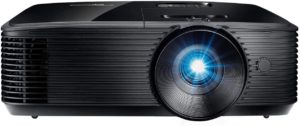
Optoma, as usual, has topped the list due to its optimal pricing structure and the decent quality and performance you’ll want in your college or school room.
The Optoma HD146X offers a 1080p resolution, which is the standard for high-definition images. You’ll be able to easily display your lesson plans and presentations, and the image quality is top-notch.
The HD146X Projector is bright, boasting 3600 lumens. This is enough to ensure that your classroom presentations will be seen clearly, even in rooms with high ambient light levels.
Optoma HD146X projector uses a DLP (Digital Light Processing) chip to deliver clear and vibrant images. It’s a single-chip design, meaning it doesn’t use a color wheel. And this results in less image degradation and better color accuracy. Lamp life is decent, too, with up to 4,000 hours of use in bright mode, 10,000 hours in eco mode, and 15,000 hours in dynamic mode.
The HD146X has a 16ms response time, which is great for gaming and watching fast-paced action movies. This Projector also has an Enhanced Gaming Mode that optimizes the image for gaming.
The Projector has a high contrast ratio of 25,000:1. Which means that bright scenes will appear clear, and dark scenes will remain detailed. The Projector also has a Dynamic Black technology that smoothes lamp output to create a high contrast ratio.
The Projector comes with a ceiling mount, which is great if you want to free up some desk or table space in the classroom. The screen size is 100″ from 10 feet away, and the screen size is up to 300 inches.
Optoma HD146X has both vertical and horizontal keystone correction. Keystone correction ensures that the image is rectangular, no matter where the Projector is placed. The keystone correction range is ±40°. The Projector has a 1.1x zoom, which is great for classrooms where space is limited. And the focus range is 0.8m – 8.0m.
The Projector has HDMI inputs, one Audio-Out port, and a USB-A (power) port. The HDMI inputs are great for connecting laptops or other devices to the Projector, and the Audio-Out port allows you to connect external speakers to the Projector. And the USB-A (power) port can be used to power the Projector or charge your devices.
The Optoma HD146X projector is a great choice for the classroom and is also a great value. It’s packed with features that you need, and it’s priced affordably.
2. Epson VS260
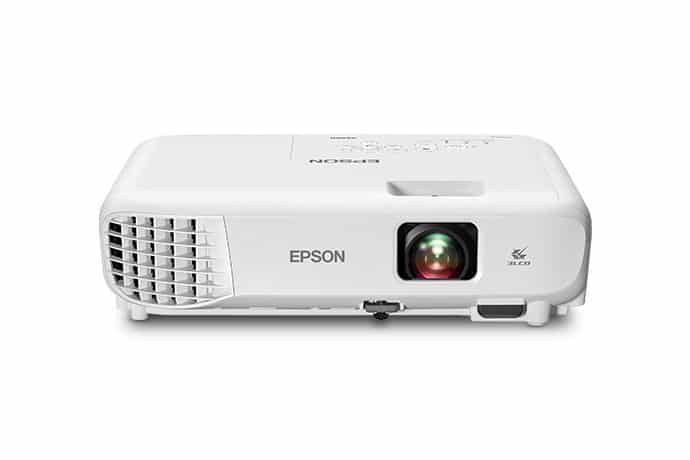
Here we have the Epson VS260, a projector with a brightness rating of 3,300 lumens of both white and color brightness. This is a projector that is well-suited for use in a classroom. With this projector, one can enjoy the ease of operation of an Epson remote control.
The VS260 comes with built in HDMI connectivity, which allows it to share content from things such as laptops easily. It also guarantees crisp images due to the contrast ratio of 15,000 to 1. Additionally, the technology included in the VS260 provides both a high-quality picture time .
This is also one of the few projectors with built in speakers where you don’t have to purchase external speakers to act as the source of sound. Aside from that, this projector comes with a skew sensor that automatically helps to center images.
3. CiBest W13 Projector

The CiBest W13 is both high quality and affordable and is suited to both home theaters and travelling. Don’t take the inexpensive price as something to turn you off from this projector – because price doesn’t always indicate value.
The W13 comes with a compact design while also weighing 2.80 pounds – its measurements are 7.91 x 5.51 x 2.76 inches. It comes with a user manual, equipment registration, a remote, HDMI cable, a screw, and a power cable. The front of this projector has a lens with a detachable lens cover. On the projector are navigation buttons including power buttons, back, and up and down and the bottom includes a screw for mounting it on a tripod.
On the rear of this projector there is a speaker, remote sensor, and a power outlet while on the left side of the projector there is an HDMI, 2 USB, VGA cable. SD, and 2 audio ports.
The W13 is said to have a brightness rating of 4200 Lumens and a contrast ratio of 2000 to 1. The LED battery in the w13 also totes a battery life 50,000 hours which technically is enough for 5 years of continuous playtime (not that that is suggested for any projector). The W13 has decent image quality with a resolution of 800 x 480 while it can also process content up to 1080p.
To use this projector, one needs to have a screen with a minimum size of 31.4 inches or 2.62 ft. At 14.8 ft, the W13 allows a large screen size of 200 in. To get an optimum watching experience one should place the projector between 3.9 and 8.2 ft away to get 60 to 80 inches for the screen. To soften the effect the projector has on eyes, it includes diffuse reflection technology.
Since it’s fairly lightweight, the W13 is easy to carry around. It comes with keystone correction and focus features which helps it to project the images accurately on the screen. This projector works well with a multitude of devices including, media players, tablets, laptops, PlayStations, fire stick etc.
4: BenQ MH733 – Full HD Business Projector
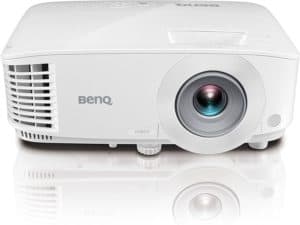
Now we add BenQ to our list of the best projectors for classroom teaching. The BenQ MH733 Business Projector is a top choice for those who want a projector with great features and the best build quality.
The BenQ MH733 Business Projector has a Full HD 1080P resolution, making it ideal for displaying high-definition content in the classroom. With a 16,000:1 contrast ratio, the Projector produces crisp images with deep blacks and bright whites.
This particular model has 4000 lumens brightness rating, ensuring that the Projector can be used in rooms with ambient light. And this Projector also has a 1.3x zoom feature, allowing you to adjust the image size without moving the Projector. And this is a great feature if you need to project onto a screen that is not the same size as the one you are using.
BenQ MH733 also has 2D keystone correction and auto vertical keystone correction. This means that the images will be automatically corrected for any distortion caused by the Projector being set up at an angle. The corner fit correction feature ensures that the images will be correctly proportioned even if the Projector is not placed in the center of the screen.
The MH733 Projector is equipped with a long-lasting lamp with a lifespan of up to 15,000 hours. This means you won’t have to replace the lamp often, which will lower the cost of ownership.
This Projector also uses high-quality, low-dispersion glass lenses to minimize chromatic aberration. This ensures long-term image quality with brilliant clarity. And Projector can project images up to 300 inches, making it perfect for large classrooms or auditoriums.
The MH733 Projector has a variety of ports and connectivity options. It has two HDMI ports, one of which is MHL-compatible. It also has a VGA port, two USB Type-A ports, one USB Type-Mini B port, and an Ethernet port. The Projector also has an audio in and audio out port and an RS232 port.
BenQ MH733 is a great choice for those who need a projector with superior image quality and a wide range of features. It is perfect for large classrooms or auditoriums, and its long-lasting lamp and high-quality lenses make it a wise investment.
5: YABER Y31 – 1080P Projector
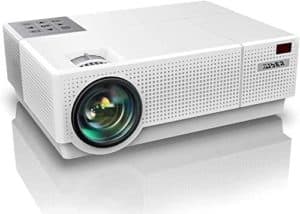
The Yaber Y31 Projector is one of the best projectors for classroom teaching, with the cheapest price tag. Yaber Y31 was launched in 2019, and this Projector is ranked as the 5th best Projector in the market.
In this Projector, Yaber Y31 uses a 1080P DLP projector Engine to project pictures and videos with the native resolution of 1080P. The physical resolution is 1920×1080, and it can play 4K videos by inputting the video signal of 1080P. It means you will see every detail of the image with this Projector.
This Yaber Y31 video projector is bright with an upgraded LED light source. The Y31 has a brightness of 9500 lumens. And contrast ratio is 10000:1, which is high. So you will see every detail of the image clearly with this Projector.
With this Projector, you will get a 4D keystone of ± 50°. So you can adjust the image by using the remote control. The aspect ratio is 16:9 and 4:3. You can use this Projector for movies and games.
The lamp life of this Projector is up to 40,000 hours. So, you don’t need to replace the lamp on this Projector. And Yaber uses the latest SmartEco technology LED lamp in this Projector. So the power consumption is low, and it is environment friendly.
This video projector has a screen size of 50 to 300 inches, and the recommended viewing distance is 10 feet. And this Projector has dual 3W speakers, so you won’t need to connect external speakers.
The Yaber Y31 projector is equipped with an improved, silent cooling system with 3 fans running simultaneously. The noise of the fan is only 26dB. So you can use this Projector in a small room without any disturbance.
In this Projector, you see 2 HDMI ports, 2 USB ports, a VGA port, an AV port, and audio output. Also, you can easily connect your external devices like Chromecast, Amazon Fire Stick TV, PC, laptop, Xbox, DVD player, USB stick, tablet, external speakers, iPad, iPhone, and Android smartphone.
6: FANGOR F-506 – Bluetooth and WiFi Projector
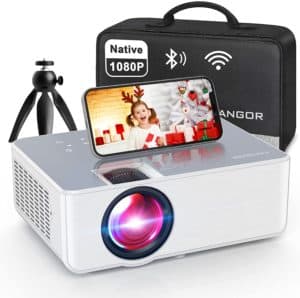
The ultimate best Projector on this list belongs to Fangor. This college projector is a WiFi and Bluetooth enabled device that can easily carry around, and it also comes with a tripod, making it the perfect tool for classroom teaching.
The Projector offers a Full HD 1080p resolution, providing clear and sharp images. It also has a high contrast ratio of 10000:1, delivering blacker blacks and whiter whites.
In this Projector, you’ll find a brightness of 5000 lumens, which is 50% higher than most projectors on the market, making it ideal for use in well-lit classrooms.
What makes the Fangor F-506 unique is its energy-saving LCD panel. This panel has a lifespan of 65,000 hours, much longer than most projectors on the market, and it means you won’t have to replace the Projector for many years.
The Fangor F-506 projector has a maximum display size of 230 inches. But we recommend using a screen size between 30 and 180 inches. As a result, you will have the best viewing experience. And the Projector comes with remote control. But you can also control the Projector with your smartphone or tablet.
In this Projector, Fangor uses a manual keystone correction function that allows you to adjust the shape of the projected image. This is especially useful when the Projector is not placed in the center of the screen.
And the focus function allows you to adjust the clarity of the image projected by the Projector. This is especially useful when the image is not clear enough. The Projector also has a built-in stereo surround speaker.
The Projector is equipped with HDMI, VGA, USB 2.0, SD card port, and AV inputs, allowing you to connect it to various devices. It’s also compatible with laptops, smartphones, and tablets. You can mirror your devices to the projector screen with WiFi (it must be a connected TV stick).
7: BenQ TK700STi – Short Throw Projector
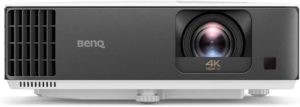
BenQ is again here on the list with its short-throw Projector. So, it justifies our list of classroom projectors. This BenQ projector is one of the best projectors on this list. We recommend you use this Projector in any type of room. Because this Projector builds for gaming, home theater, business presentation, and school college project.
This BenQ projector has a 4K resolution and a low input lag of 16ms at 4K/60Hz. So, you can play all the latest game consoles and any type of video. The image quality is also good. And it’s a short-throw projector. So, it will project a 100″ image from only 6.5 feet away.
It has a 3000-lumen brightness. So, it will be bright enough for any presentation or movie in the classroom. And it also comes with an RGBRGB color wheel. So, it will produce accurate colors.
The BenQ TK700STi is a DLP projector. It uses an RGBRGB color wheel. So, it will produce accurate colors. The Projector has a lamp life of up to 15,000 hours in eco mode. So, it will last a long time.
The TK700STi has a contrast ratio of 10,000:1. So, so it will produce deep black levels. The Projector also has a refresh rate of 60Hz. So, it will be smooth for gaming, movies, and any type of video. And this projector project has a screen size of up to 220 inches, and the screen will be 150 inches when you mount the Projector 10 feet away from the screen.
The BenQ TK700STi projector comes with 1.2x zoom and 2D keystone correction. So, you can place the Projector on the side, and it will still project a clear image. The keystone correction will also help to eliminate trapezoid effects. Also, the Projector has a corner fit correction. So, it will fit the image to the screen even if the Projector is not inward-outward.
This Projector has a Google-certified Android TV. So, you can access the Google Play store and any type of Android app. Also, you get 5,000 plus of the latest Android apps. You can also access movies, shows, live sports, games, music, and more.
You can cast via AirPlay or Chromecast. So, you can enjoy photos, videos, music, and other content on the big screen. This Projector supports Google assistant; you can also access and discover new entertainment. And you just say the show’s name or movie to start watching.
The TK700STi Projector has 2 HDMI ports. So, you can connect any type of device to it. It also has a USB port. So, you can connect a USB drive to it. The Projector also has an audio out port. It supports external speakers, so you can connect them. Lastly, the Projector has a VGA port. So, you can connect a PC or laptop to it.
The Projector is compatible with the Xbox One, PS4, Wii U, PCs, laptops, and tablets. So, you can connect any of those devices to it.
Overall, this is a great projector for the classroom. And it’s also a great projector for gaming, movies, and any type of video. The image quality is good. And it has low input lag for gaming. Also, the Projector is bright enough for any presentation or movie in the classroom.
8. Epson Home Cinema 880
The Epson Home Cinema has a 1920 by 1080 native resolution, 3-chip 3LCD technology, and a brightness rating an 3,300 ANSI lumens. Aside from those features mentioned above, this projector provides good color accuracy, meaning that it will work well for either a home cinema or a classroom/business setting.
Since it has an HDMI input option, things such as gaming consoles, blu-ray players, or cable boxes can be connected to it. The HC880 supports Mira casting with mobile devices meaning that tablets, smartphones, or laptops can be connected. It also comes with 2D keystone correction with a range of plus or minus 30 degrees in both dimensions. This feature greatly reduces the trapezoid effect. One can adjust the keystone manually using the display sub-menu or allow the machine to do it automatically.
The HC880 is a basic projector that uses a lamp based light source and doesn’t have much in the way of smart features. It has a lamp life average of 6,000 hours which means that one can enjoy years of use from it.
9. BenQ MW560
The BenQ MW560 is great for displaying multimedia content or project presentations on to large screens. This projector has a stated brightness rating of 4,000 ANSI lumens and a contrast ratio of 20,000 to 1. It also has a number of picture modes that adjust the projector settings to accommodate for a number of content types.
The MW560 also comes with a number of input types such as S-video, VGA, Composite video, and HDMI which allow different devices to be connected to it (cable/satellite box, Blu-ray player, laptop, etc.) It also comes with an IR remote and VGA cable for added convenience.
White Board Touch Screen setup
Best projector for classroom teaching: Conclusion paragraph
So, what are the best projectors for classroom teaching? We’ve shared our top picks and outlined everything you need to know before making your purchase. With the right Projector, you can engage your students and make learning fun and interactive.
Classroom teaching is a challenging but rewarding profession – we hope this guide has helped make your decision easier and given you some great ideas for using technology in the classroom.
